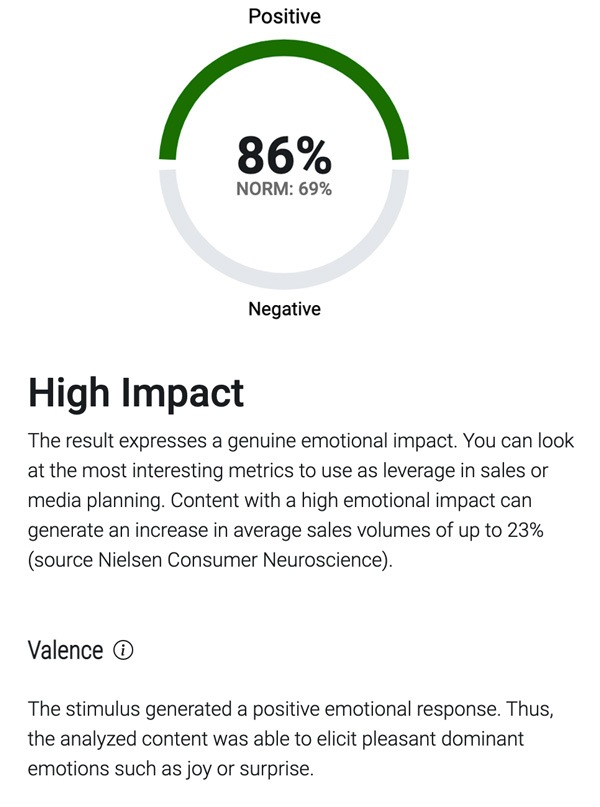How Emotion Could Drive Your Campaigns to Succeed
Marketing campaigns have seconds to captivate its audience, with recent ones showing that using emotions can make a difference in delivering a message effectively. We explore the range of emotions and examples of emotional marketing in real life.
Key Points
- While over 30 emotions exist, only six emotions can be easily recognized through facial expressions
- Emotions such as joy can be measured in a marketing campaign using Emotion AI technology
- Different real-life examples of emotional marketing show how to captivate audiences
Different types of emotions used in marketing campaigns
Professor Robert Plutchik introduced the “Wheel of Emotions” in 1980 “…as a visual tool for understanding his psycho-evolutionary theory.”

In addition to the Wheel of Emotions, but before that,, psychologist and professor at the University of California, Paul Ekman, studied seven emotions, six of which can be easily recognized by facial expressions:
- Joy
- Sadness
- Fear
- Disgust
- Surprise
- Anger
- Contempt (experts debate if this is a distinct emotion)
Facial reactions provide insight into how someone might perceive a marketing campaign.
>YOU MIGHT LIKE: [White Paper] How to be confident with your marketing decisions
Examples of emotional advertising
According to The Drum, emotional advertising: “… refers to the relationship between a customer and a brand or a product, particularly the emotional connection that appeals to the customer’s emotional state, ego, needs, fears and aspirations through content.”
Let us take a look at examples of emotional advertising or marketing campaigns that have successfully used each of the six emotions that are easily recognized through facial expressions. We will leave “contempt” out for now.
An ad that sparks joy
Ad summary: Apple’s Saving Simon Ad
 In 2021, Apple released a holiday commercial shot with its newest model, iPhone 13. The video starts with a detailed close-up of a yellow textured scarf and moves to show the rippling skin of a carrot and reveals the top of a snowman’s delicately assembled head, all created by a little girl. The video continues to show how the little girl does everything she can to keep the snowman alive until winter returns again the following year, with her family supporting her throughout the journey.
In 2021, Apple released a holiday commercial shot with its newest model, iPhone 13. The video starts with a detailed close-up of a yellow textured scarf and moves to show the rippling skin of a carrot and reveals the top of a snowman’s delicately assembled head, all created by a little girl. The video continues to show how the little girl does everything she can to keep the snowman alive until winter returns again the following year, with her family supporting her throughout the journey.
Why this is a good example of using joy in emotional advertising
So many emotions run throughout the entire commercial but the viewer walks away feeling a sense of joy in reminiscing of their own childhood joy, the love of family, and the power of capturing and living in the moment.
In a recent case study, Emotiva tested this commercial using the Emotion AI (artificial intelligence) tool, EmPower, to measure its true impact. The Apple commercial scored the highest in generating a genuine emotional impact at 85%, when compared to two other holiday commercials.
>>See the entire ad in our Christmas Ads case study
An ad that sparks sadness
Ad summary: Chevrolet – Holiday Ride Ad
Chevrolet also released a holiday ad that tapped into several layers of sadness. The ad tells the story of a daughter, father, and a beat-up 1966 Chevrolet Impala. The father flashes back to a happier time when his young wife loved to drive the car. In an act of love, the daughter restores the car and surprises her father as a Christmas gift.
Why this is a good example of using sadness in emotional advertising
The ad takes the subject of loss and turns it into a story of resilience. While the years have taken a toll on the Chevy Impala, a bit of love and support bring it back to its full glory. Much like the Impala, the father in the ad learns to smile again, balancing out the sadness felt in the beginning. The ad also does a nice job of reminding us of the legacy that Chevrolet, a 110-year old automotive brand, still holds and the value that its most prized vehicles still carry.
An ad that invokes fear
Ad summary: Second Hand-Smoke Dark Balloons
The California Department of Health released an ad that starts innocently. The scenes cut to different people as they go about their daily lives – going to work, at home, at the park. But slowly, shadows of black balloons start to emerge and then become clear in view. The balloons represent how second-hand smoke can lurk in the most unlikely places.
Why this is a good example of using fear in emotional advertising
Balloons seem to be harmless as does the risk of second-hand smoke. The commercial pushes the idea that people are not safe from second-hand smoke no matter where they are. It uses the feelings of fear for bystanders who are not smokers and guilt for the smokers themselves, who might also fear that they can hurt their loved ones or innocent people, without purposefully trying to hurt them.
An ad that fills you with disgust
Ad Summary: Burger King’s Moldy Whopper
One of the most controversial and viral marketing campaigns of all time used disgust for an unlikely purpose: to promote the promise of freshness. The infamous Burger King “Moldy Whopper” ad shows the various stages of a whopper until it reaches the disturbingly late stages of decay. The main message centers around the lack of preservatives, meaning the whopper uses fresh ingredients.
Why this is a good example of using disgust in emotional advertising
While you normally wouldn’t associate mold with promoting a food product, the Burger King Moldy Whopper campaign speaks directly to an audience who very much cares about what they put into their body. It also addresses a common opinion that fast food is unhealthy because of its use of preservatives by providing undeniable evidence of fresh ingredients.
An ad made to surprise you
Ad Summary: Volkswagen – Eyes on the Road
It looks like a typical movie theater, with people making their way to their seats and getting ready to watch a movie. The pre-movie trailers begin to play on the screen, showing someone driving in their car. After a few seconds, everyone in the movie theater receives a text message, taking their attention away from the screen. Shortly after, a loud crash jolts the audience back to the screen revealing a message about mobile use as a leading cause of death for drivers.
Why this is a good example of using surprise in emotional advertising
The unexpectedness of the text message and car crash immediately shock the audience. The surprise factor helps to associate Volkswagen with being more than just an automotive brand trying to sell a car. It shows they care about the wellbeing of everyone, not just their direct customers.
An ad that might anger you
Ad Summary: The Truth is Worth It – New York Times
The video begins with the word ‘rumors’ on the screen and a reporter talking in the background. The talking continues, words continue to appear, while you hear someone typing notes as they interview people. As a viewer, it’s difficult to believe what is being said or shown because it points to a shocking truth. It then becomes clear what the interviews are about – proving whether a suspected controversial immigration policy is in place. The interviews continue, photos emerge proving suspicions and the video ends with words forming a news headline: “Hundreds of Immigrant Children Have Been Taken From Parents at U.S. Border.”
Why this is a good example of using anger in emotional advertising
The New York Times’ goal for this ad centers around the rigorous efforts reporters go through to find the truth about a subject that invokes anger, without letting personal emotions or biases get in the way.
Ready to understand how to use emotion to help your campaigns succeed?
We walk through using emotion to make better marketing decisions in our white paper.
DOWNLOAD YOUR FREE WHITE PAPER


































